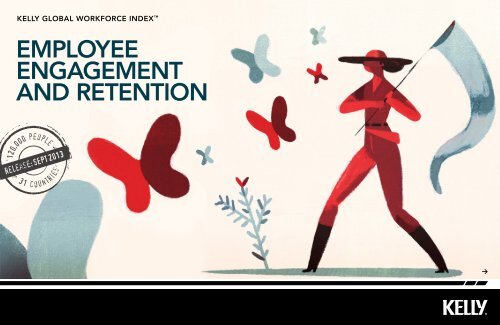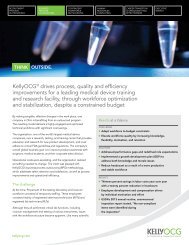Employee Engagement and Retention - Kelly Services - News ...
Employee Engagement and Retention - Kelly Services - News ...
Employee Engagement and Retention - Kelly Services - News ...
Create successful ePaper yourself
Turn your PDF publications into a flip-book with our unique Google optimized e-Paper software.
kelly Global workforce index <br />
EMPLOYEE<br />
ENGAGEMENT<br />
AND RETENTION<br />
120,000 people<br />
release: SEPT 2013<br />
31 countries
<strong>Employee</strong><br />
contentment: 2013<br />
The economic environment is testing the employee/employer<br />
partnership, with employees ready <strong>and</strong> willing to switch jobs<br />
should a better prospect arise. Almost half of all respondents,<br />
globally, have changed employers in the past year, with the<br />
greatest rate of job-changers in the EMEA region.<br />
Job change: More than 50%<br />
Job CHange: Less than 50%<br />
Globally<br />
52 %<br />
are happy in their<br />
current jobs<br />
43 %<br />
It’s not all about the money<br />
Key factors influencing<br />
job choice<br />
38%<br />
Work/life<br />
balance<br />
29%<br />
Personal<br />
growth/<br />
advancement<br />
26%<br />
Compensation/<br />
benefits<br />
job change in the past year<br />
Australia 62%<br />
France 61%<br />
Portugal 58%<br />
Denmark 56%<br />
Brazil 55%<br />
New Zeal<strong>and</strong> 55%<br />
Luxembourg 55%<br />
Belgium 53%<br />
Netherl<strong>and</strong>s 53%<br />
Switzerl<strong>and</strong> 50%<br />
South Africa 21%<br />
Puerto Rico 30%<br />
Indonesia 31%<br />
India 33%<br />
Germany 34%<br />
China 34%<br />
Thail<strong>and</strong> 35%<br />
Malaysia 36%<br />
Singapore 39%<br />
Norway 41%<br />
frequently think<br />
about quitting<br />
55 %<br />
actively look for a better<br />
job, even when happy in<br />
their current role<br />
Key factors influencing<br />
potential employees<br />
Location<br />
54% 53% 51%<br />
Corporate<br />
br<strong>and</strong><br />
Corporate<br />
culture<br />
10<br />
MOST<br />
VOLATILE<br />
10<br />
LEAST<br />
VOLATILE<br />
63 %<br />
say their manager has<br />
a direct influence on<br />
their job satisfaction<br />
26 %<br />
how to be a better manager<br />
Aside from salary/benefits, there are<br />
a few key elements that can improve<br />
the manager-employee relationship<br />
53%<br />
46%<br />
37%<br />
feel more loyal to<br />
their employer when<br />
compared with a<br />
year ago<br />
Training<br />
opportunities<br />
Clarify<br />
responsibilities,<br />
goals <strong>and</strong><br />
objectives<br />
More<br />
transparent<br />
communications
contents<br />
Section 1:<br />
4 Introduction<br />
5 Employment Volatility (by Region)<br />
6 Employment Volatility (by Country)<br />
7 Happiness with Job Switch (by Region)<br />
8 Happiness with Job Switch<br />
(by Generation)<br />
9 Willingness to Recommend Employer<br />
10 Factors Influencing an<br />
Employer Referral<br />
11 Impact of Direct Managers<br />
on <strong>Employee</strong> Satisfaction<br />
12 What Managers Need To Do<br />
Section 2:<br />
13 Introduction<br />
14 <strong>Employee</strong> Happiness<br />
15 <strong>Employee</strong> Loyalty<br />
16 Key Factors Influencing Job Choice<br />
17 Critical Factors in Job Evaluation<br />
18 Determinants of Employer Reputation<br />
Section 3:<br />
19 Introduction<br />
20 <strong>Employee</strong> Commitment to Job<br />
21 Intention to Switch Jobs<br />
22 <strong>Employee</strong>s Contemplating Quitting<br />
23 Constant Job Scanning<br />
24 Frequency of Job Scanning<br />
25 Conclusion<br />
The <strong>Kelly</strong> Global<br />
Workforce Index 2013<br />
The 2013 <strong>Kelly</strong> Global Workforce Index<br />
(KGWI) brings together work <strong>and</strong> workplace<br />
insights sourced from more than 120,000<br />
respondents from 31 countries across the<br />
Americas, EMEA <strong>and</strong> APAC regions.<br />
It takes the form of an annual survey that<br />
canvasses a wide spectrum of opinions on issues<br />
impacting the contemporary workplace, with a<br />
particular focus on the perspectives from different<br />
generations, industries, occupations <strong>and</strong> skill sets.<br />
Topics covered in the 2013 KGWI survey include:<br />
• Career Development <strong>and</strong> Upskilling<br />
• Workplace Performance<br />
• <strong>Employee</strong> <strong>Engagement</strong> <strong>and</strong> <strong>Retention</strong><br />
• Social Media <strong>and</strong> Technology<br />
This third installment, on the topic of <strong>Employee</strong><br />
<strong>Engagement</strong> <strong>and</strong> <strong>Retention</strong>, looks in some depth<br />
at the employee-employer relationship, including<br />
issues such as employee loyalty, happiness <strong>and</strong><br />
commitment to the job. It also examines views<br />
about the employer’s reputation as a preferred<br />
place to work, <strong>and</strong> the circumstances under which<br />
employees explore alternative jobs <strong>and</strong> careers.<br />
<strong>Kelly</strong> Global Workforce Index<br />
3
section 1<br />
Why employees are moving<br />
The economic upheaval over recent years has had an unsettling impact on<br />
many employees who have chosen to switch jobs in search of career certainty<br />
<strong>and</strong> financial security.<br />
Unfortunately, many of those who do make the switch face difficulties settling in to<br />
their new roles, with uncertain outcomes for them <strong>and</strong> their new employers.<br />
There is a big challenge for employers in managing the onboarding of new recruits<br />
so that they are productive <strong>and</strong> integrate well into the organization.<br />
Simply changing jobs does not make for contented employees, <strong>and</strong> a big factor<br />
is the way that managers <strong>and</strong> supervisors h<strong>and</strong>le the transition.<br />
<strong>Kelly</strong> Global Workforce Index<br />
4
employment volatility (by region)<br />
Å Almost half of respondents globally,<br />
Employment Volatility by region Option B<br />
(47%) have changed employers<br />
Have Employment you changed Volatility by region employers Option Bwithin the past year? (% “Yes” by Region)<br />
within the past year, with the greatest<br />
Americas<br />
rate of job-change in the EMEA<br />
region (51%) compared with the<br />
Americas (45%) <strong>and</strong> APAC (42%).<br />
Globally, 36% said they have<br />
Americas<br />
45%<br />
EMEA<br />
45%<br />
34%<br />
34%<br />
21%<br />
21%<br />
EMEA<br />
considered changing jobs, while<br />
51% 34% 15%<br />
just 17% claim that they are not<br />
51% 34% 15%<br />
interested in changing employers.<br />
Yes<br />
No, but I have considered<br />
No, but I have considered<br />
changing employers<br />
changing employers<br />
No, I am not interested in<br />
No, changing I am employers not interested in<br />
changing employers<br />
APAC<br />
APAC<br />
42% 40% 18%<br />
Global<br />
42% 40% 18%<br />
Global<br />
47% 36% 17%<br />
47% 36% 17%<br />
<strong>Kelly</strong> Global Workforce Index<br />
5
employment volatility (by country)<br />
Å By country, both Australia <strong>and</strong> France<br />
saw more than 60% of respondents<br />
change jobs in the past year.<br />
More than 50% switched jobs in<br />
Portugal, Denmark, Brazil,<br />
New Zeal<strong>and</strong> <strong>and</strong> Netherl<strong>and</strong>s.<br />
Employment Have you Volatility changed by country employers within the past year? (% “Yes” by Country)<br />
70<br />
60<br />
62 61 58 56 55 55 55 53 53 50 50 49 49 46 46 45 44 43 43 42 42 41 39 36 35 34 34 33 31 30 21<br />
EMEA<br />
APAC<br />
America<br />
The lowest rates of job-change were in<br />
South Africa (21%), Puerto Rico (30%),<br />
Indonesia (31%), <strong>and</strong> India (33%).<br />
50<br />
40<br />
30<br />
20<br />
10<br />
0<br />
Australia<br />
France<br />
Portugal<br />
Denmark<br />
Brazil<br />
New Zeal<strong>and</strong><br />
Luxembourg<br />
Belgium<br />
Netherl<strong>and</strong>s<br />
Switzerl<strong>and</strong><br />
UK<br />
Canada<br />
Pol<strong>and</strong><br />
Mexico<br />
Hungary<br />
Hong Kong<br />
Italy<br />
Irel<strong>and</strong><br />
Russia<br />
US<br />
Sweden<br />
Norway<br />
Singapore<br />
Malaysia<br />
Thail<strong>and</strong><br />
China<br />
Germany<br />
India<br />
Indonesia<br />
Puerto Rico<br />
South Africa<br />
<strong>Kelly</strong> Global Workforce Index<br />
6
happiness with job switch (by region)<br />
Å It is worth noting that a change of<br />
jobs does not automatically translate<br />
into a more contented employee.<br />
Happiness with job Switch by region<br />
If you have changed employers in the past year, are you happy in your new role/job? (% “Very Happy” or “Happy” by Region)<br />
Less than half (48%) of the global<br />
respondents who changed jobs are<br />
actually happy in their new roles.<br />
AMERICAS<br />
EMEA<br />
APAC<br />
GLOBAL<br />
However, the job-changing experience<br />
varies in different global markets.<br />
In APAC, almost two-thirds (64%) of<br />
job-changers are happy in their new<br />
positions, compared with only 43%<br />
in EMEA <strong>and</strong> 41% in the Americas.<br />
41% 43%<br />
64% 48%<br />
<strong>Kelly</strong> Global Workforce Index<br />
7
happiness with job switch (by generation)<br />
Å There is quite a difference in the<br />
employment outcomes of those<br />
who do change jobs among the<br />
various workplace generations.<br />
If Happiness you have with changed job switch employers - generation in the past year, are you happy in your new role/job? (% “Very Happy” or “Happy” by Generation)<br />
Gen Y have a considerably better result,<br />
with 54% reporting they are happy in<br />
their new roles, compared with 47% for<br />
GEN Y<br />
GEN X<br />
BABY BOOMERS<br />
Gen X <strong>and</strong> just 40% for Baby Boomers.<br />
54% 47%<br />
40%<br />
<strong>Kelly</strong> Global Workforce Index<br />
8
Willingness to recommend employer<br />
Å A key indicator of employee<br />
satisfaction is the willingness of an<br />
employee to recommend their employer<br />
as a preferred place to work.<br />
How likely would you be to recommend your employer to a friend or colleague as an employment opportunity?<br />
Willingness (Respondents to recommend rating 9 & employer 10 on a scale of 1–10 where 1 = “Definitely would not” <strong>and</strong> 10 = “Definitely would”)<br />
Globally, just 29% say they would be<br />
strongly inclined to recommend their<br />
employer to a friend or colleague<br />
AMERICAS<br />
EMEA<br />
APAC<br />
GLOBAL<br />
as an employment opportunity.<br />
But there are sharply differing views<br />
across the globe from employees<br />
regarding their employers.<br />
While 42% of respondents in the<br />
Americas would strongly recommend<br />
their employer to friends or colleagues,<br />
only 28% of those in APAC <strong>and</strong> 24%<br />
in EMEA would be willing to do so.<br />
42% 24%<br />
28% 29%<br />
<strong>Kelly</strong> Global Workforce Index<br />
9
factors influencing an employer referral<br />
Å Among respondents who would<br />
recommend their employer to a<br />
friend or colleague as an employment<br />
opportunity, 26% cite “company culture/<br />
reputation” as the primary influence for<br />
the recommendation. The second most<br />
influential reason is “opportunity for<br />
personal growth/advancement”, at 21%.<br />
The issue of “competitive compensation/<br />
benefits” was noted as most<br />
influential by a small portion—<br />
only 10% of respondents.<br />
Which of the following factors are most influential in terms of the likelihood that you would recommend your employer?<br />
(Globally, Factors influencing respondents an Employer who referral rated 9 or 10 on a scale of 1–10, where 10 = “most likely to recommend”)<br />
21%<br />
10%<br />
26%<br />
2%<br />
14%<br />
9%<br />
17%<br />
1%<br />
Company culture/<br />
reputation<br />
Opportunity for<br />
personal<br />
growth/<br />
advancement<br />
Interesting or<br />
challenging work<br />
Personal<br />
fulfillment<br />
(work/life<br />
balance)<br />
Competitive<br />
compensation<br />
benefits<br />
Flexible work<br />
schedule<br />
Other<br />
Opportunity for<br />
telecommuting<br />
(working from<br />
home or<br />
remotely)<br />
<strong>Kelly</strong> Global Workforce Index<br />
10
Impact of direct managers on employee satisfaction<br />
Å It is sometimes said that<br />
employees don’t leave companies,<br />
they leave managers.<br />
To what degree does your direct manager/supervisor impact your level of satisfaction or engagement with your employment?<br />
(Respondents Impact of Direct who Manager rated on 4 <strong>Employee</strong> & 5 on a Satisfaction scale of 1–5, where 5 = “significant impact” <strong>and</strong> 1 = “no impact at all”<br />
Certainly the influence of managers<br />
on employee morale <strong>and</strong> work<br />
performance is significant.<br />
Globally 63% of respondents say<br />
AMERICAS<br />
EMEA<br />
APAC<br />
GLOBAL<br />
that their direct managers have a<br />
significant impact on the level of<br />
their satisfaction <strong>and</strong> engagement,<br />
with the highest in APAC (68%).<br />
63% 60%<br />
68% 63%<br />
<strong>Kelly</strong> Global Workforce Index<br />
11
what managers need to do<br />
Å When employees are asked to reflect<br />
on the performance of their managers,<br />
there are a few key elements that are<br />
presented as ways of better addressing<br />
the manager-employee relationship.<br />
What could your direct manager do to improve your satisfaction or level of engagement, aside from salary/benefits or promotion?<br />
(Global, What managers multiple need to responses)<br />
do<br />
Topping the list is the opportunity<br />
for more training <strong>and</strong> skills<br />
development, followed by the need<br />
for managers to better clarify the<br />
responsibilities, goals <strong>and</strong> objectives<br />
53%<br />
46%<br />
37%<br />
25%<br />
23% 23%<br />
8%<br />
of those under their direction.<br />
The third ranked request is for more<br />
transparency in communications<br />
between employees <strong>and</strong> managers.<br />
Training opportunities<br />
Clarify responsibilities,<br />
goals, <strong>and</strong> objectives<br />
More<br />
transparency with<br />
communications<br />
More<br />
reasonable<br />
manageable<br />
workload<br />
Public<br />
recognition<br />
More<br />
autonomy<br />
Other<br />
<strong>Kelly</strong> Global Workforce Index<br />
12
section 2<br />
underst<strong>and</strong>ing what works<br />
The world of work plays a pivotal part in all our lives, <strong>and</strong> the factors that<br />
contribute to a successful job or career are complex <strong>and</strong> intertwined.<br />
Happiness in work is often defined as a key determinant of success, but jobs also<br />
need to fulfil a range of emotional, cultural, <strong>and</strong> economic needs.<br />
The way that people feel about their work, view their work, <strong>and</strong> the manner in<br />
which they select certain jobs all play an important part in the way workforces are<br />
developed <strong>and</strong> managed.<br />
<strong>Kelly</strong> Global Workforce Index<br />
13
<strong>Employee</strong> happiness<br />
Å The survey poses to employees<br />
the threshold question “Are<br />
you happy in your job?”<br />
Approximately half of global<br />
respondents (52%) say that they are<br />
either “happy” or “very happy” in<br />
their jobs. The result in 2013 is little<br />
changed from the figure in 2012.<br />
<strong>Employee</strong> Happiness by region<br />
Are you happy in your job? (% “Happy” <strong>and</strong> “Very Happy” by Region)<br />
70%<br />
60%<br />
2013<br />
2012<br />
The geographic picture is more intriguing.<br />
Those in APAC are consistently more<br />
content in their positions, with 63%<br />
either “happy” or “very happy”,<br />
significantly higher than in the<br />
Americas (53%) <strong>and</strong> EMEA (46%).<br />
50%<br />
40%<br />
30%<br />
Americas<br />
EMEA<br />
APAC<br />
Global<br />
<strong>Kelly</strong> Global Workforce Index<br />
14
<strong>Employee</strong> loyalty<br />
Å The idea of employee “loyalty” to an<br />
employer is one that has come under<br />
considerable stress during the global<br />
economic downturn <strong>and</strong> its aftermath.<br />
Perhaps not surprisingly, employee<br />
loyalty is relatively low <strong>and</strong> falling, down<br />
from 29% in 2012 to 26% in 2013.<br />
<strong>Employee</strong> Loyalty by region<br />
Compared with a year ago, do you feel more or less loyal to your employer? (“More loyal” by Region)<br />
50%<br />
40%<br />
2013<br />
2012<br />
In the Americas <strong>and</strong> APAC, employee<br />
loyalty sits above 30%, but in EMEA it is<br />
just 19%, down from 22% a year earlier.<br />
30%<br />
20%<br />
10%<br />
Americas<br />
EMEA<br />
APAC<br />
Global<br />
<strong>Kelly</strong> Global Workforce Index<br />
15
key factors influencing job choice<br />
Å The key factor influencing job choice<br />
across all generations was “personal<br />
fulfilment (work/life balance)”, nominated<br />
by 38% globally. This is of particular<br />
importance to the older respondents<br />
than those in the younger generations.<br />
Another key factor is “personal growth/<br />
advancement”, which is nominated by<br />
29% globally, but the data suggests<br />
this factor may be less important as<br />
people progress through their careers.<br />
Key Factors influencing job choice<br />
Which of the following factors would drive your decision to accept one job/position over another? (By Generation)<br />
50%<br />
40%<br />
30%<br />
Gen Y<br />
Gen X<br />
Baby Boomers<br />
All generations<br />
The issue of “compensation/<br />
benefits” ranks third most important<br />
at 26% globally <strong>and</strong> remains largely<br />
steady across the generations.<br />
20%<br />
10%<br />
0%<br />
Personal fulfillment<br />
(work/life balance)<br />
Personal growth/<br />
advancement<br />
Compensation/<br />
benefits<br />
Corporate sovereignty/<br />
goodwill<br />
Other<br />
<strong>Kelly</strong> Global Workforce Index<br />
16
Critical factors in job evaluation<br />
Å Of the host of issues that are weighed<br />
up by employees in deciding on the<br />
right job, the prime consideration is<br />
location, cited by 54% globally.<br />
Critical factors in job evaluation<br />
What factors are most important to you when evaluating a potential employer or job opportunity? (Global)<br />
A close second is “corporate br<strong>and</strong>/<br />
41%<br />
reputation” nominated by 53%.<br />
Other elements that touch on an<br />
employer’s business performance, culture,<br />
54%<br />
53%<br />
51%<br />
48%<br />
35%<br />
21% 3%<br />
<strong>and</strong> benefits are still important to many.<br />
Location<br />
Corporate br<strong>and</strong>/<br />
reputation<br />
Corporate<br />
culture<br />
Financial<br />
Performance<br />
Flexible work<br />
arrangements<br />
offered<br />
Longevity<br />
Turnover<br />
statistics<br />
Other<br />
<strong>Kelly</strong> Global Workforce Index<br />
17
Determinants of employer reputation<br />
Å In the eyes of the employee, there<br />
is one issue that dominates when it<br />
comes to evaluating an employer’s<br />
reputation – employment stability.<br />
When considering the reputation of a potential employer, what factors are most important? (Global)<br />
Determinants of Employer reputation<br />
Globally, an overwhelming 75%<br />
of respondents say that a stable<br />
employment environment is their<br />
prime consideration in judging the<br />
reputation of a potential employer.<br />
The second most frequently cited<br />
75%<br />
50%<br />
43%<br />
41%<br />
31%<br />
2%<br />
factor is strong leadership (50%),<br />
followed by innovation (43%).<br />
Employment stability Strong leadership Innovation Fun corporate<br />
culture<br />
Corporate social<br />
responsibility/<br />
philanthropy<br />
Other<br />
<strong>Kelly</strong> Global Workforce Index<br />
18
section 3<br />
staying or switching?<br />
The global economic recession had a profound impact on the way employees<br />
view their work <strong>and</strong> their employers.<br />
For employees worldwide, job stability took precedence over improved<br />
salaries <strong>and</strong> benefits as business activity slowed <strong>and</strong> thous<strong>and</strong>s were laid off.<br />
Many firms that had built employee goodwill over decades had to make the<br />
difficult decision to scale back operations <strong>and</strong> reduce headcount.<br />
It is only some years after the worst of this economic crisis that we are seeing<br />
the lasting effect on employee attitudes <strong>and</strong> behaviour.<br />
<strong>Kelly</strong> Global Workforce Index<br />
19
<strong>Employee</strong> commitment to job<br />
Å One-third of respondents, globally,<br />
describe themselves as “totally<br />
committed” to their employers, up only<br />
slightly from 31% the previous year.<br />
The picture varies across the globe.<br />
All regions saw increases in the level<br />
of commitment, with the highest level<br />
in the Americas (40%), compared with<br />
34% in APAC <strong>and</strong> 28% in EMEA.<br />
<strong>Employee</strong> Committment to job by region<br />
How committed or “engaged” do you feel with your current employer? (% “Totally Committed” by Region)<br />
50%<br />
40%<br />
2013<br />
2012<br />
30%<br />
20%<br />
10%<br />
Americas<br />
EMEA<br />
APAC<br />
Global<br />
<strong>Kelly</strong> Global Workforce Index<br />
20
Intention to switch jobs<br />
Å When it comes to changing employers,<br />
the number of people intending to look for a<br />
job with another organization has decreased.<br />
A total of 63% of workers intend to look<br />
for a job with another organization within<br />
the next year, down from 66% in 2012.<br />
Intention to switch job (by region<br />
Do you intend to look for a job with another organization within the next year? (“Yes” by Region)<br />
80%<br />
2013<br />
2012<br />
Virtually all of the difference is accounted<br />
for by a big downward shift in the Americas<br />
from 66% to 56%.<br />
70%<br />
Job-switching plans are down only slightly<br />
in APAC from 62% to 61% <strong>and</strong> steady in<br />
EMEA at 67%.<br />
60%<br />
50%<br />
40%<br />
Americas<br />
EMEA<br />
APAC<br />
Global<br />
<strong>Kelly</strong> Global Workforce Index<br />
21
employees contemplating quitting<br />
Å There are many employees who<br />
are in a constant state of disquiet in<br />
their employment arrangement. They<br />
spend a considerable amount of time<br />
considering other job options.<br />
Globally, 43% say they frequently think<br />
about quitting their current job <strong>and</strong><br />
going to another employer. This is a<br />
jump from 37% reported in 2012.<br />
<strong>Employee</strong>s Contemplating Quitting<br />
Do you frequently think about quitting your current job <strong>and</strong> leaving your employer? (“Yes” by Region)<br />
60%<br />
50%<br />
2013<br />
2012<br />
Across all regions, there is a rise in the<br />
number of people who are frequently<br />
thinking about quitting, with the biggest<br />
increase in EMEA, up from 43% to 50%.<br />
40%<br />
30%<br />
20%<br />
Americas<br />
EMEA<br />
APAC<br />
Global<br />
<strong>Kelly</strong> Global Workforce Index<br />
22
constant job scanning<br />
Å Even employees who are happy in<br />
their jobs spend a considerable amount of<br />
time canvassing employment alternatives.<br />
Constant job scanning by region<br />
Do you actively look for better job opportunities or evaluate the external job market even when you are happy in a job? (“Yes” by Region)<br />
70%<br />
More than half of global respondents<br />
(55%) say they actively look for a<br />
better job even when they are happy<br />
in their current job, a significant<br />
increase from 49% in 2012.<br />
60%<br />
2013<br />
2012<br />
The trend is evident across all regions.<br />
The most active job-scanners are<br />
in EMEA (59%) followed by APAC<br />
(57%) <strong>and</strong> the Americas (45%).<br />
50%<br />
40%<br />
30%<br />
Americas<br />
EMEA<br />
APAC<br />
Global<br />
<strong>Kelly</strong> Global Workforce Index<br />
23
Frequency of job scanning<br />
Å Keeping one eye on the jobs<br />
market can be a time-consuming<br />
activity for those who are constantly<br />
looking for alternatives.<br />
More than one-quarter (29%) of job<br />
seekers look once or twice a week,<br />
<strong>and</strong> over one-third (34%) look for a<br />
new opportunity on a daily basis.<br />
How frequently do you look for a better opportunity or evaluate the external job market?<br />
Frequency of Job scanning<br />
(Among those who actively do so even when happy in their job, by Region)<br />
50%<br />
40%<br />
Americas<br />
EMEA<br />
APAC<br />
All countries<br />
In EMEA, no less than 44% say they<br />
check the jobs market on a daily basis,<br />
while 30% do so once or twice a week.<br />
30%<br />
20%<br />
10%<br />
0%<br />
Daily<br />
Once or twice a week<br />
Once or twice a month<br />
Less than once a month<br />
<strong>Kelly</strong> Global Workforce Index<br />
24
Conclusion<br />
looking forward, not back<br />
Many workers have experienced a significant shift in their<br />
attachment to employers in the wake of the global financial crisis,<br />
<strong>and</strong> this phenomenon is still shaping the employment relationship.<br />
The difficult economic environment tested<br />
the employee-employer partnership in<br />
many organizations, <strong>and</strong> it still lingers<br />
in the minds of some workers.<br />
<strong>Employee</strong>s appear less content in their<br />
positions <strong>and</strong> are mindful about the<br />
importance of keeping their options open.<br />
There is a transactional element to the<br />
way employees view their employment—<br />
less emotional attachment, <strong>and</strong> a more<br />
rational, arm’s-length assessment of<br />
career prospects <strong>and</strong> alternatives.<br />
In this relatively fickle environment,<br />
employees are readily making<br />
judgment calls about the reputation<br />
of their employers <strong>and</strong> are ready to<br />
switch jobs should the need arise.<br />
Importantly, the variable state of the<br />
economic recovery across the globe is<br />
reflected in markedly less optimism in<br />
EMEA than in the Americas <strong>and</strong> APAC,<br />
where conditions are more buoyant.<br />
<strong>Kelly</strong> Global Workforce Index<br />
25
About the kelly global workforce index<br />
The <strong>Kelly</strong> Global Workforce Index (KGWI) is an annual global survey revealing opinions<br />
about work <strong>and</strong> the workplace. Approximately 122,000 people across the Americas, EMEA<br />
<strong>and</strong> APAC regions responded to the survey. This survey was conducted online by RDA Group<br />
on behalf of <strong>Kelly</strong> <strong>Services</strong>.<br />
About <strong>Kelly</strong> services ®<br />
<strong>Kelly</strong> <strong>Services</strong>, Inc. (NASDAQ: KELYA, KELYB) is a leader in providing workforce solutions.<br />
<strong>Kelly</strong> ® offers a comprehensive array of outsourcing <strong>and</strong> consulting services as well as world-class<br />
staffing on a temporary, temporary-to-hire, <strong>and</strong> direct-hire basis. Serving clients around the globe,<br />
<strong>Kelly</strong> provides employment to more than 560,000 employees annually. Revenue in 2012 was<br />
$5.5 billion. Visit kellyservices.com <strong>and</strong> connect with us on Facebook, LinkedIn, <strong>and</strong> Twitter.<br />
Download The Talent Project, a free iPad app by <strong>Kelly</strong> <strong>Services</strong>.<br />
An Equal Opportunity Employer © 2013 <strong>Kelly</strong> <strong>Services</strong><br />
kellyservices.com<br />
<strong>Kelly</strong> Global Workforce Index<br />
EXIT<br />
26














